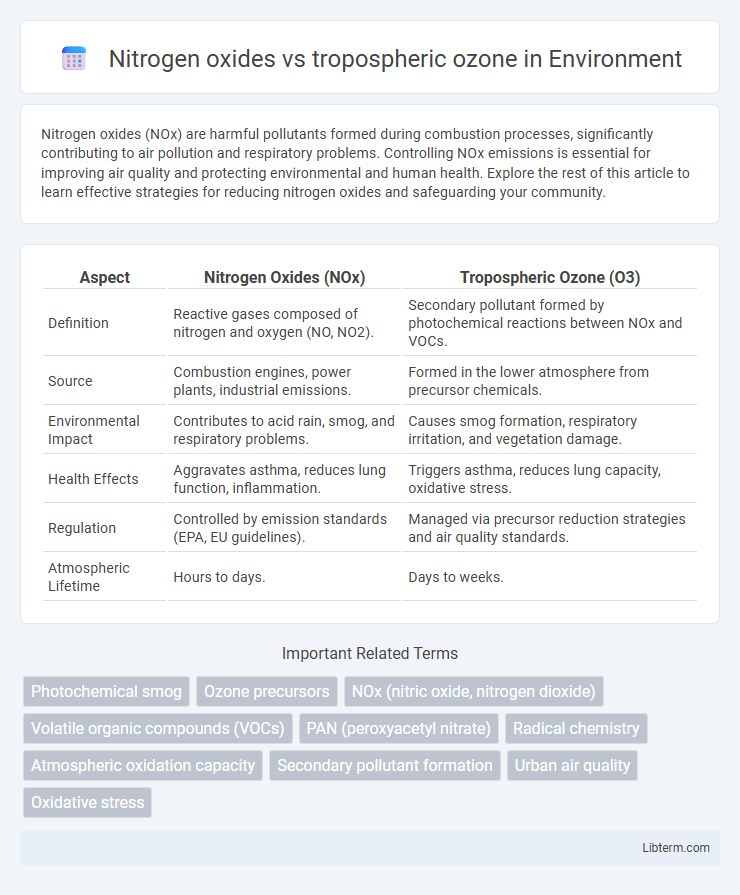Nitrogen oxides (NOx) are harmful pollutants formed during combustion processes, significantly contributing to air pollution and respiratory problems. Controlling NOx emissions is essential for improving air quality and protecting environmental and human health. Explore the rest of this article to learn effective strategies for reducing nitrogen oxides and safeguarding your community.
Table of Comparison
| Aspect | Nitrogen Oxides (NOx) | Tropospheric Ozone (O3) |
|---|---|---|
| Definition | Reactive gases composed of nitrogen and oxygen (NO, NO2). | Secondary pollutant formed by photochemical reactions between NOx and VOCs. |
| Source | Combustion engines, power plants, industrial emissions. | Formed in the lower atmosphere from precursor chemicals. |
| Environmental Impact | Contributes to acid rain, smog, and respiratory problems. | Causes smog formation, respiratory irritation, and vegetation damage. |
| Health Effects | Aggravates asthma, reduces lung function, inflammation. | Triggers asthma, reduces lung capacity, oxidative stress. |
| Regulation | Controlled by emission standards (EPA, EU guidelines). | Managed via precursor reduction strategies and air quality standards. |
| Atmospheric Lifetime | Hours to days. | Days to weeks. |
Introduction to Nitrogen Oxides and Tropospheric Ozone
Nitrogen oxides (NOx), comprising nitric oxide (NO) and nitrogen dioxide (NO2), are primary pollutants produced mainly from combustion processes in vehicles and industrial activities. Tropospheric ozone (O3) forms through photochemical reactions involving NOx and volatile organic compounds (VOCs) under sunlight, playing a significant role in air quality and atmospheric chemistry. Elevated levels of NOx and ozone contribute to smog formation, respiratory health issues, and environmental damage, highlighting the importance of monitoring and controlling these pollutants.
Sources of Nitrogen Oxides in the Atmosphere
Nitrogen oxides (NOx), primarily including nitric oxide (NO) and nitrogen dioxide (NO2), are emitted mainly from combustion processes such as vehicle engines, power plants, and industrial activities. Natural sources like lightning and microbial activity in soils also contribute to atmospheric NOx levels. These nitrogen oxides play a crucial role in the formation of tropospheric ozone by reacting with volatile organic compounds (VOCs) under sunlight.
Formation Mechanisms of Tropospheric Ozone
Tropospheric ozone forms primarily through photochemical reactions involving nitrogen oxides (NOx) and volatile organic compounds (VOCs) under sunlight. Nitrogen oxides, emitted from combustion processes, catalyze the oxidation of VOCs, producing ozone as a secondary pollutant. This formation mechanism is temperature-dependent and critically influenced by the ratio of NOx to VOCs in the atmosphere.
Chemical Interactions Between Nitrogen Oxides and Ozone
Nitrogen oxides (NOx), primarily composed of nitric oxide (NO) and nitrogen dioxide (NO2), play a critical role in tropospheric ozone formation and destruction. NO reacts with ozone (O3) to form NO2 and O2, while NO2 photolyzes under sunlight to produce NO and atomic oxygen, which subsequently reacts with molecular oxygen (O2) to regenerate ozone, creating a dynamic photochemical cycle. This interplay governs ozone levels in the lower atmosphere, impacting air quality and contributing to photochemical smog formation.
Environmental Impacts of Nitrogen Oxides
Nitrogen oxides (NOx) play a critical role in the formation of tropospheric ozone, a major component of smog, which adversely affects respiratory health and ecosystem integrity. NOx emissions from vehicles, power plants, and industrial sources contribute to acid rain, nutrient pollution, and visibility degradation, significantly impacting air quality and biodiversity. Controlling NOx levels is essential for reducing ozone concentrations and mitigating environmental and health risks associated with photochemical smog.
Health Effects of Tropospheric Ozone Exposure
Tropospheric ozone exposure causes respiratory issues, including reduced lung function, asthma exacerbation, and increased hospital admissions for respiratory diseases. Nitrogen oxides (NOx) contribute to ozone formation, indirectly impacting public health by increasing ground-level ozone concentrations. Long-term exposure to elevated tropospheric ozone levels leads to chronic respiratory conditions and heightened sensitivity to airborne allergens.
Role of Nitrogen Oxides in Urban Air Pollution
Nitrogen oxides (NOx), primarily emitted from vehicle exhaust and industrial activities, significantly contribute to urban air pollution by serving as precursors in the formation of tropospheric ozone (O3). In the presence of sunlight, NOx reacts with volatile organic compounds (VOCs), leading to photochemical smog characterized by elevated ozone levels harmful to respiratory health. Controlling NOx emissions is crucial for mitigating urban ozone pollution and improving air quality standards.
Nitrogen Oxides and Ozone: Regulatory Standards
Nitrogen oxides (NOx) and tropospheric ozone (O3) are regulated under air quality standards such as the U.S. EPA's National Ambient Air Quality Standards (NAAQS) due to their significant impact on human health and the environment. NOx emissions, primarily from combustion processes, contribute to ozone formation and are targeted with specific emission limits to reduce ground-level ozone concentrations. Regulatory frameworks set maximum allowable concentrations for NOx and ozone, enforcing monitoring, control technologies, and emission reduction strategies to mitigate smog and respiratory issues.
Strategies for Reducing Nitrogen Oxides and Ozone Levels
Effective strategies for reducing nitrogen oxides (NOx) and tropospheric ozone involve implementing stringent emission controls on vehicles and industrial sources, such as catalytic converters and low-NOx burners. Enhancing public transportation, promoting electric vehicles, and adopting cleaner fuel technologies contribute to lowering NOx emissions, which directly decreases ozone formation since NOx is a key precursor. Urban planning that reduces traffic congestion and increases green spaces further aids in mitigating ozone production and improving air quality.
Future Perspectives on Nitrogen Oxides and Tropospheric Ozone Management
Emerging strategies for managing nitrogen oxides (NOx) emphasize advanced catalytic converters and real-time emission monitoring to reduce NOx precursor emissions effectively. Enhanced tropospheric ozone control focuses on integrated air quality models that predict ozone formation under varying NOx levels combined with volatile organic compounds (VOCs). Future perspectives prioritize synergistic policies targeting simultaneous NOx and VOC reductions to mitigate ozone pollution and improve public health outcomes.
Nitrogen oxides Infographic

 libterm.com
libterm.com